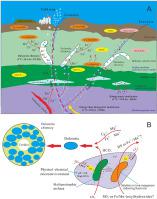当前位置:
X-MOL 学术
›
Mar. Petrol. Geol.
›
论文详情
Our official English website, www.x-mol.net, welcomes your feedback! (Note: you will need to create a separate account there.)
Formation of dolomites from the newly discovered ancient cold seep in the Middle Dongsha area of the South China Sea
Marine and Petroleum Geology ( IF 4.2 ) Pub Date : 2024-04-03 , DOI: 10.1016/j.marpetgeo.2024.106829 Hong Cao , Zhilei Sun , Xilin Zhang , Xia Zhang , Nengyou Wu , Wei Geng , Zike jiang , Bin Zhai , Yunbao Sun , Xuejun Jiang , Dong Zhang , Aiguo Dong
Marine and Petroleum Geology ( IF 4.2 ) Pub Date : 2024-04-03 , DOI: 10.1016/j.marpetgeo.2024.106829 Hong Cao , Zhilei Sun , Xilin Zhang , Xia Zhang , Nengyou Wu , Wei Geng , Zike jiang , Bin Zhai , Yunbao Sun , Xuejun Jiang , Dong Zhang , Aiguo Dong

|
Remotely operated vehicle (ROV) observations have recently revealed seep dolomite deposits covering the seafloor on Middle Dongsha of the South China Sea (SCS). Spurred by these findings, we studied the mineralogical and geochemical properties to examine the seep dolomite’s origin, precipitation mechanism, and formation environment. These carbonates mainly comprise dolomite (from 64 to 84 wt%), followed by small amounts of calcite (from 1 to 3 wt%), locally containing magnesite (∼4 wt%), and goethite (∼14 wt%). Extensively developed mineralized cells containing high Mg and Ca contents found in chimneys imply that microbially-mediated processes probably participated in the reactivation of dolomite precipitation. The moderate and concentrated δC values (from −36.64 to −39.16‰, V-PDB) indicated that the carbon in carbonates was mainly derived from thermogenic methane. The methane fluids most likely ascended beneath the volcaniclastic unit and inherited enriched positive Eu anomalies due to fluid–rock interactions during their seepage along tectonic faults to the seafloor. The δO values (4.2–4.8‰, V-PDB) of carbonate suggested that an O-depleted fluid was involved in carbonate precipitation. The high total Rare-Earth Element contents (ΣREE) of seep carbonates varied from 61 ppm to 92 ppm, reflecting the chemical composition of surrounding pore waters at the time of carbonate precipitation, exhibiting less mixing with seawater. It may also indicate higher alkalinity and pH of the pore water. Although the sea-like REE patterns (HREE-enriched, negative Ce anomalies) are not caused by seawater, they may be due to the complexation competition between humic acid (HA) and carbonate for REE at high pore-water alkalinity and high CO concentrations. This is consistent with the dolomite chimney pointing toward a formation environment in relatively deep sediments, in particular, close to the sulfate-methane interface in sediments, where the bicarbonate concentration reaches its maximum due to AOM. Moderate Mo and no U enrichments appeared in the carbonates, suggesting a relatively lower intensity of methane seepages with relatively reduced AOM rates. The wide range of (Mo/U) values and U–Mo covariation indicates the very dynamic AOM rate (slow to moderate) and redox conditions (mostly suboxic–anoxic, occasionally sulfidic conditions) during carbonate formation due to episodically changing seepage activity.
中文翻译:

南海东沙中部新发现古冷泉白云岩的形成
遥控潜水器(ROV)观测最近揭示了南海东沙中部海底覆盖的渗流白云石矿床。在这些发现的推动下,我们研究了矿物学和地球化学性质,以研究渗流白云石的起源、沉淀机制和形成环境。这些碳酸盐主要包括白云石(64至84重量%),其次是少量方解石(1至3重量%),局部含有菱镁矿(〜4重量%)和针铁矿(〜14重量%)。在烟囱中发现的含有高镁和钙含量的广泛发育的矿化细胞意味着微生物介导的过程可能参与了白云石沉淀的重新激活。中等且集中的 δ13C 值(从-36.64 到-39.16‰,V-PDB)表明碳酸盐中的碳主要来自热成因甲烷。甲烷流体很可能在火山碎屑单元下方上升,并由于在沿构造断层渗漏至海底期间的流体-岩石相互作用而继承了富集的正铕异常。碳酸盐的δ18O值(4.2–4.8‰,V-PDB)表明碳酸盐沉淀涉及贫O流体。渗流碳酸盐的稀土元素总含量 (ΣREE) 较高,从 61 ppm 到 92 ppm 不等,反映了碳酸盐沉淀时周围孔隙水的化学成分,与海水的混合较少。它还可能表明孔隙水的碱度和 pH 值较高。虽然类似海的稀土元素模式(富含 HREE、负 Ce 异常)不是由海水引起的,但它们可能是由于在高孔隙水碱度和高 CO 浓度下腐殖酸 (HA) 和碳酸盐之间对 REE 的络合竞争造成的。这与白云石烟囱指向相对较深的沉积物中的形成环境一致,特别是靠近沉积物中的硫酸盐-甲烷界面,其中由于AOM,碳酸氢盐浓度达到最大值。碳酸盐中出现了中等程度的钼富集,没有出现铀富集,这表明甲烷渗漏强度相对较低,AOM 率相对较低。大范围的 (Mo/U) 值和 U-Mo 共变表明,由于渗流活动的间歇性变化,碳酸盐形成过程中存在非常动态的 AOM 速率(慢到中等)和氧化还原条件(主要是低氧-缺氧,偶尔是硫化物条件)。
更新日期:2024-04-03
中文翻译:

南海东沙中部新发现古冷泉白云岩的形成
遥控潜水器(ROV)观测最近揭示了南海东沙中部海底覆盖的渗流白云石矿床。在这些发现的推动下,我们研究了矿物学和地球化学性质,以研究渗流白云石的起源、沉淀机制和形成环境。这些碳酸盐主要包括白云石(64至84重量%),其次是少量方解石(1至3重量%),局部含有菱镁矿(〜4重量%)和针铁矿(〜14重量%)。在烟囱中发现的含有高镁和钙含量的广泛发育的矿化细胞意味着微生物介导的过程可能参与了白云石沉淀的重新激活。中等且集中的 δ13C 值(从-36.64 到-39.16‰,V-PDB)表明碳酸盐中的碳主要来自热成因甲烷。甲烷流体很可能在火山碎屑单元下方上升,并由于在沿构造断层渗漏至海底期间的流体-岩石相互作用而继承了富集的正铕异常。碳酸盐的δ18O值(4.2–4.8‰,V-PDB)表明碳酸盐沉淀涉及贫O流体。渗流碳酸盐的稀土元素总含量 (ΣREE) 较高,从 61 ppm 到 92 ppm 不等,反映了碳酸盐沉淀时周围孔隙水的化学成分,与海水的混合较少。它还可能表明孔隙水的碱度和 pH 值较高。虽然类似海的稀土元素模式(富含 HREE、负 Ce 异常)不是由海水引起的,但它们可能是由于在高孔隙水碱度和高 CO 浓度下腐殖酸 (HA) 和碳酸盐之间对 REE 的络合竞争造成的。这与白云石烟囱指向相对较深的沉积物中的形成环境一致,特别是靠近沉积物中的硫酸盐-甲烷界面,其中由于AOM,碳酸氢盐浓度达到最大值。碳酸盐中出现了中等程度的钼富集,没有出现铀富集,这表明甲烷渗漏强度相对较低,AOM 率相对较低。大范围的 (Mo/U) 值和 U-Mo 共变表明,由于渗流活动的间歇性变化,碳酸盐形成过程中存在非常动态的 AOM 速率(慢到中等)和氧化还原条件(主要是低氧-缺氧,偶尔是硫化物条件)。



























 京公网安备 11010802027423号
京公网安备 11010802027423号